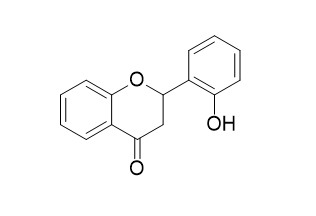2'-Hydroxyflavanone
2’-Hydroxyflavanone shows antiproliferative, anti-angiogenic and prodifferentiation properties on Renal cell carcinoma. 2'‐Hydroxyflavanone ameliorates mesenteric angiogenesis and portal‐systemic collaterals in rats with liver fibrosis, it induces apoptosis of human osteosarcoma 143 B cells by activating the extrinsic TRAIL- and intrinsic mitochondria-mediated pathways. 2’-Hydroxyflavanone showed inhibitory effect on platelet aggregation caused by two inducers with IC50 47.8± 2.1 AA and 147.2 ± 4.1 ADP.
Inquire / Order:
manager@chemfaces.com
Technical Inquiries:
service@chemfaces.com
Tel:
+86-27-84237783
Fax:
+86-27-84254680
Address:
1 Building, No. 83, CheCheng Rd., Wuhan Economic and Technological Development Zone, Wuhan, Hubei 430056, PRC
Providing storage is as stated on the product vial and the vial is kept tightly sealed, the product can be stored for up to
24 months(2-8C).
Wherever possible, you should prepare and use solutions on the same day. However, if you need to make up stock solutions in advance, we recommend that you store the solution as aliquots in tightly sealed vials at -20C. Generally, these will be useable for up to two weeks. Before use, and prior to opening the vial we recommend that you allow your product to equilibrate to room temperature for at least 1 hour.
Need more advice on solubility, usage and handling? Please email to: service@chemfaces.com
The packaging of the product may have turned upside down during transportation, resulting in the natural compounds adhering to the neck or cap of the vial. take the vial out of its packaging and gently shake to let the compounds fall to the bottom of the vial. for liquid products, centrifuge at 200-500 RPM to gather the liquid at the bottom of the vial. try to avoid loss or contamination during handling.
Int J Mol Sci.2024, 25(2):764.
Plants (Basel).2021, 10(2):278.
Molecules.2021, 26(12):3652.
J Ethnopharmacol.2020, 254:112733.
J.Korean Soci. Food Sci. Nutri.2024, 53(11):1166-1177
Mal J Med Health Sci.2024, 20(SUPP5):151-156.
Sci Rep.2024, 14(1):3684.
Front Pharmacol.2021, 12:615157.
The Korea Society of Pha.2014, 300-314
Food Chem.2023, 424:136383.
Related and Featured Products
Carcinogenesis, 2011 Apr;32(4):568-75.
2'-hydroxyflavanone inhibits proliferation, tumor vascularization and promotes normal differentiation in VHL-mutant renal cell carcinoma.[Pubmed:
21304051]
Renal cell carcinoma (RCC) is one of the top ten cancers prevalent in USA. Loss-of-function mutations in the von Hippel-Lindau (VHL) gene constitute an established risk factor contributing to 75% of total reported cases of RCC. Loss-of-VHL leads to a highly vascularized phenotype of renal tumors. Intake of citrus fruits has been proven to reduce the risk of RCC in multicenter international studies.
METHODS AND RESULTS:
Hence, we studied the effect of 2'-Hydroxyflavanone (2HF), an active anticancer compound from oranges, in RCC. Our in vitro investigations revealed that 2HF suppresses VHL-mutant RCC to a significantly greater extent than VHL-wild-type RCC by inhibiting epidermal growth factor receptor signaling, which is increased due to VHL mutations in RCC. Our results also revealed for the first time, that 2HF inhibits glutathione S-transferase pi activity. 2HF reduced cyclin B1 and CDK4 levels and induced G2/M phase arrest in VHL-mutant RCC. Importantly, 2HF inhibited the angiogenesis in VHL-mutant RCC by decreasing vascular endothelial growth factor expression. Our in vivo studies in mice xenografts confirmed our in vitro results as evident by decreased levels of proliferation marker, Ki67 and angiogenic marker, CD31, in 2HF-treated mice xenografts of VHL-mutant RCC. 2HF also increased the expression of E-cadherin in VHL-mutant RCC, which would be of significance in restoring normal epithelial phenotype.
CONCLUSIONS:
Collectively, our in vitro and in vivo results revealed the potent antiproliferative, anti-angiogenic and prodifferentiation properties of 2HF in VHL-mutant RCC, sparing normal cells, which could have significant implications not only in the specific management of VHL-mutant RCC but also towards other VHL syndromes.
Oriental Journal of Chemistry, 2013, 29(3):871-875.
Antiplatelet aggregation activity of Hydroxyflavane, 2’-Hydroxyflavanone, Paeonol and bergenin isolated from stem bark of Garcinia malaccensis in human whole blood.[Reference:
WebLink]
METHODS AND RESULTS:
Four known compounds, 5-Hydroxyflavone (1), 2'-Hydroxyflavanone (2), Paeonol (3) and bergenin (4), were isolated from the methanolic extract of the stem bark of Garcinia malaccensis for the first time through combination of vacuum and radial chromatography techniques. The structures of the secondary metabolites (1-4) were elucidated on the basis of their spectroscopic evidence and comparison with the published data. All isolated compounds exhibited inhibition of platelet aggregation in human whole blood which induced by arachidonic acid (AA), adenosine diphosphate (ADP) and collagen.
CONCLUSIONS:
2'-Hydroxyflavanone (2) showed inhibitory effect on platelet aggregation caused by two inducers with IC50 47.8± 2.1 AA and 147.2 ± 4.1 ADP.
Journal of Gastroenterology & Hepatology, 2016, 31(5):1045-1051.
2'-Hydroxyflavanone ameliorates mesenteric angiogenesis and portal-systemic collaterals in rats with liver fibrosis.[Pubmed:
26474184]
Portal-systemic collaterals lead to dreadful consequences in patients with cirrhosis. Angiogenesis participates in the development of liver fibrosis, hyperdynamic circulation, and portal-systemic collaterals. 2'-Hydroxyflavanone (2'-HF), one of the citrus fruits flavonoids, is known to have antiangiogenesis effect without adverse response. However, the relevant effects in liver fibrosis have not been surveyed.
METHODS AND RESULTS:
Male Wistar rats received thioacetamide (TAA, 100 mg/kg tiw, i.p.) for 6 weeks to induce liver fibrosis. On the 29th to 42nd day, rats randomly received 2'-HF (100 mg/kg, qod, i.p.) or vehicle (corn oil). On the 43rd day, after hemodynamic measurements, the followings were surveyed: (i) severity of collaterals; (ii) mesenteric angiogenesis; (iii) mesenteric proangiogenic factors protein expressions; (iv) Mesenteric vascular endothelial cells apoptosis; and (v) Mesenteric expressions of proteins regulating apoptosis. Compared with the vehicle group, 2'-HF did not significantly change body weight, mean arterial pressure, heart rate, and portal pressure in TAA rats. 2'-HF significantly alleviated the severity of collaterals, but the mesenteric phospho-ERK, ERK, phospho-Akt, Akt, COX1, COX2, VEGF, and VEGFR-2 protein expressions were not altered. The apoptotic index of 2'-HF group was significantly higher and the mesenteric protein expressions of pro-apoptotic factors, NFkB 50, NFkB 65, Bax, phospho-p53, 17 kD cleaved caspase 3, and 17 kD casepase 3 were up-regulated.
CONCLUSIONS:
2'-HF does not influence the hemodynamics but alleviated the severity of collaterals in rats with liver fibrosis and early portal hypertension. This is, at least partly, attributed to enhanced apoptosis of mesenteric vascular endothelial cells.



